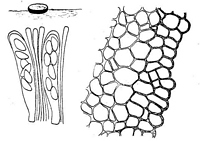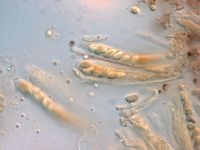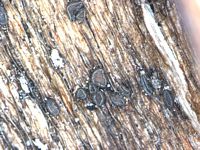|
 Pseudopeziza colensoi Pseudopeziza colensoi
SynonymsCenangium colensoi
BiostatusPresent in region - Indigenous. Endemic
Images (click to enlarge)
Caption: FIG. 3 Pseudopeziza colensoi. Habit sketch x 10, details x 660. | 
Caption: Ascospores, about 8-11 x 4-5 µm.
Owner: P.R. Johnston | 
Caption: Apothecia about 0.5 mm diam. (dried specimen)
Owner: P.R. Johnston |
Article: Berkeley, M.J. (1855). Fungi. Flora Novae-Zelandiae. Part II. Flowerless Plants. The Botany of the Antarctic Voyage II Hooker, J.D. (eds.) 378 p. 172-210, 338 London: Lovell Reeve.
Description: Scattered, at first covered with the cuticle, at length expanded, externally brown; disc pale,
faintly tinged with pink. Asci oblong. Sporidia elliptic, subcymbiform, hyaline, 1/4000 of an
inch long.
Habitat: On dead leaves, apparently of Phormium, Colenso.
Article: Dennis, R.W.G. (1961). Some inoperculate Discomycetes from New Zealand. Kew Bulletin 15(2): 293-320.
Description: Apothecia gregarious, erumpent, orbicular, disc flat, pallid, about i mm. across, receptacle
smooth, sooty brown. Flesh soft, white, composed of isodiametric cells about 10 µ diameter;
excipulum formed of 2-3 layers of similar cells with dark brown walls; asci cylindric-clavate,
8-spored, 60-70 x 8-10 µ, apex somewhat thickened and pore not blued by Melzer's reagent;
ascospores uniseriate to irregularly biseriate, elliptical or inequilateral, 9-12.5 x 3.5-5 µ,
hyaline, nonseptate; paraphyses cylindrical, slightly enlarged to 3 µ at the obtuse apex.
Article: Massee, G.E. (1896) [1895-97]. Redescriptions of Berkeley's types of fungi. Journal of the Linnean Society. Botany 31: 462-525 London: (http://194.203.77.76/LibriFungorum/Search.asp?ItemType=J).
Description: Ascophores gregarious or scattered, covered at first by the epidermis of the host-plant, then
erumpent, oblong at first, and with the opposite sides of the excipulum incurved, then
expanding and becoming orbicular and concave; substance thin, soft; 2-3 mm. across; disc
pale watery-grey, often with a tinge of pink, externally and the margin glabrous, dark brown;
hypothecium and excipulum hyaline, delicately parenchymatous, passing into large, dark
brown cells at the cortex ; asci cylindric-clavate, apex slightly narrowed, and not tinged blue
with iodine; spores 8, irregularly 2-seriate, continuous, hyaline, smooth, elliptical, often
slightly inaequilateral, 7x4 µ paraphyses slender.
Habitat: On dead leaves of Phormium tenax. New Zealand
Notes: The species is not a Cenangium, as considered by Berkeley; the soft, watery substance,
glabrous exterior, and not being fasciculate or caespitcose in habit, are against this idea. On
the other hand, the fungus is a typical Pseudopeziza, and should in future stand as .P.
Colensoi.
The elongated form of the fungus when young is caused by growing between the parallel rigid
vascular bundle's of the host-plant ; when it first bursts through the epidermis, it opens by a
long, narrow slit, as in Hysterium, but gradually expands and becomes circular and widely
open.
|